Pteronophobia is the fear of feathers, feathered objects i.e., birds, or being tickled by feathers. As a turkey hunter I’ll go out on a limb and say turkey hunters aren’t likely to suffer the “fear of feathered objects” part of this affliction. Why? Aside from a turkey’s soul shaking gobble, its breathtakingly stunning plumage captivates us when a strutting spring gobbler’s sun-kissed feathers magically beam a kaleidoscope of colors declaring its majesty. Our hearts may skip a beat and breaths quicken, though not out of fear, but reverent gratitude. As you stroke the feathers of your next tagged turkey take a moment to contemplate the miracle of their perfection.
To better understand the form, function and maintenance of feathers important insight is included from wild turkey expert and researcher, Dr. Michael J. Chamberlain, PhD., Terrell Distinguished Professor of Wildlife Ecology and Management at Warnell School of Forestry and Natural Resources at the University of Georgia.
Turkey feathers come in a stunning array of colors and patterns, making them some of the most beautiful feathers found in North America. While domesticated turkeys have been selectively bred to have mostly white feathers, wild turkeys display plumage in a range of striking earth tones and iridescent hues.
Understanding the colors and markings of turkey feathers helps bird enthusiasts appreciate and identify these remarkable birds. In this article, we’ll explore the various colors and patterns that make up a turkey’s plumage.
Overview of Turkey Feather Colors
Wild turkeys sport feathers in earthy browns, blacks, grays, and rusty oranges. Certain feathers may also contain iridescent tones of copper, bronze and green. The male turkey, known as a tom or gobbler, has the brightest and most vividly colored plumage, especially during mating season.
Both male and female turkeys have distinctive feather groups that include:
- Body feathers
- Wing feathers (primary, secondary and tertiary)
- Tail feathers
- Beard (found on male chest)
- Snood (fleshy projection on male’s forehead)
The colors and patterns differ between these feather groups, as well as between sexes, seasons ages, and subspecies.
Male vs Female Body Feathers
A turkey’s body is covered in thousands of overlapping body feathers that provide insulation Body feathers have a fluffier texture than flight feathers,
- Males: Mostly iridescent bronze, copper and green. Intricate, mottled patterns of brown, black, white, orange and chestnut.
- Females: Earthy tones of buff, brown and black. Neatly barred with thin black and white bands.
During mating season, male body feathers become much more vibrant, changing to brilliant reds, oranges, greens and blues.
Wing Feathers
Turkeys have three main groups of flight feathers on their wings:
- Primary feathers – Longest feathers at the wingtip
- Secondary feathers – Medium-length feathers under primaries
- Tertiary feathers – Shorter feathers towards the body
These stiff, aerodynamic feathers allow turkeys to fly short distances. Their colors help identify between male and female turkeys.
- Males: Primaries tipped white with bold black-and-white bars. Secondaries have bronze, chestnut, and iridescent green.
- Females: Primaries narrowly barred brown and black. Secondaries in camouflage browns and grays.
Tail Feathers
A turkey’s tail feathers or rectrices, act as rudders during flight. They are much longer in males than females.
- Males: 18+ inches long. Chestnut brown with black, brown and white bands. Tipped creamy white or buff.
- Females: 12 inches long. Narrowly barred blackish-brown and gray. Tipped buff or chestnut.
During courtship, males will flare and fan their tail feathers to attract females.
Snood and Beard
Two unique features found only on male turkeys are the snood and beard. These fleshy growths protrude from their faces and chests.
- Snood – Bright red or bluish flap over the beak. Elongates during courtship.
- Beard – Cluster of specialized black feathers resembling coarse hair. Grows 6-12 inches long.
What Influences Turkey Feather Colors?
Several factors impact the specific shades and patterns of turkey feathers:
- Sex – Male plumage is much more vibrant than females.
- Season – Feather colors intensify for spring mating, are dullest after summer molting.
- Age – Younger birds have less defined patterns in new feathers.
- Subspecies – The 6 wild turkey subspecies have minor variations in colors.
- Diet – Nutrition can also affect feather pigmentation.
The Significance of Turkey Feather Colors
The stunning colors and patterns of turkey plumage serve important natural purposes:
- Camouflage allows females to blend into their surroundings while nesting.
- Vibrant males attract females during courtship displays.
- Iridescent feathers signal fitness and health when finding a mate.
For indigenous cultures, turkey feathers carried symbolic meaning and were used in tribal ceremonies and rituals. Many tribes considered the wild turkey a sacred bird.
What Colors Are Domestic Turkey Feathers?
Through years of selective breeding, domestic turkeys have feathers in a wider variety of colors compared to their wild cousins. Some common domestic turkey feather colors include:
- White – The most common color, widely raised for meat production.
- Bronze – Dark feathers with chestnut, copper and russet iridescence.
- Blue slate – Slate gray feathers with a blue sheen.
- Black – Glossy black plumage throughout the body.
- Red bourbon – Rich dark reddish-brown feathers.
The particular feather colors are associated with specific heritage breeds like Narragansett, Blue Slate, Bourbon Red, and Black Spanish.
What Are the Rarest Turkey Feather Colors?
Due to their limited numbers, heritage turkey breeds with unique feather colors are quite rare. Some of the rarest turkey feather colors include:
- White Holland – Entirely bright white plumage.
- Lavender – Pale lavender-gray feathers with light lilac hues.
- Chocolate – Milk chocolate brown feathers throughout.
- Auburn – Light reddish-brown feathers referenced since the 1800s.
Seeing one of these uncommon turkey feather colors in the wild would be quite a special sighting for any birder or outdoor enthusiast.
Studying Turkey Feather Structure
Examining the structure of turkey feathers up close allows you to appreciate their incredible details. A feather’s central shaft attaches it to the bird’s body. The calamus is the base of the shaft beneath the skin. The rachis is the portion protruding above the skin.
The vane consists of barbs spreading out from the rachis. Small barbules with hooklets interconnect the barbs, creating a smooth unified surface. Using a magnifier reveals the tiny architecture that gives feathers their characteristics.
With feathers up to 6,000 on one turkey, there is an amazing diversity of colors, patterns and structures to discover.
The dazzling colors of wild and domesticated turkeys are one of nature’s wonders. Their vibrant plumage plays important roles in camouflage, attracting mates, and signaling fitness. Whether shimmering in iridescent greens or patterned in earth tones, turkey feathers are a beautiful and complex marvel of biology.
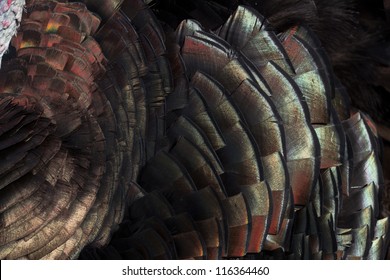
Wild Turkey Feather Facts
Feathers serve in insulation, waterproofing, protection, concealment and recognition. A turkey’s 5,000 to 6,000 feathers are arranged in tracts, or pterylae. Feathers are composed mostly of keratin, a strong lightweight protein as in our hair and nails. The hollow base is the quill, or calamus. While the feather is growing blood vessels pass through it. The supply cuts off when it’s fully grown. The shaft, or rachis is the midrib extending through the feather’s center giving it stiffness and structure. Rising from both sides of the shaft are small, pigment-embedded structures called barbs. Tiny barbules branch off and lock the barbs together. Tinier hooked barbicels at the barbule’s end hold the feathers completely interlocked in a Velcro like manner. Together they form the soft and colorful vane. Feathers are layered like shingles giving the body shape and aerodynamics necessary for flight. A muscle controls each feather allowing it to move left or right, up or down, fluff or lay flat.
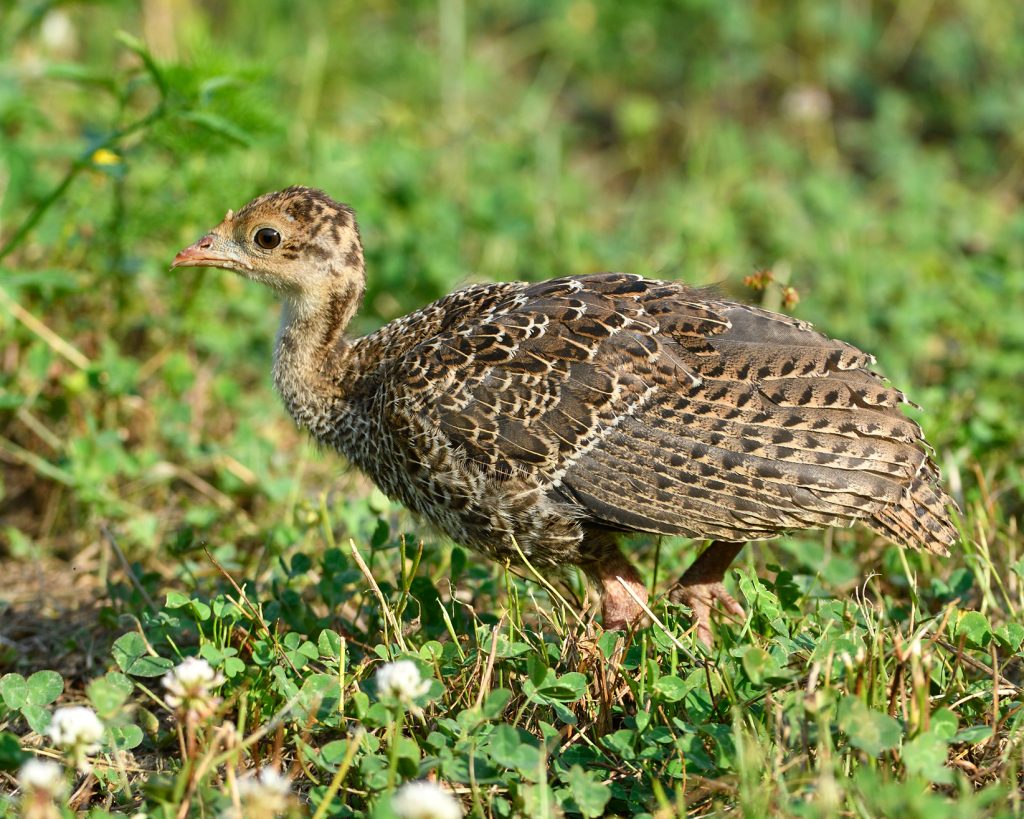
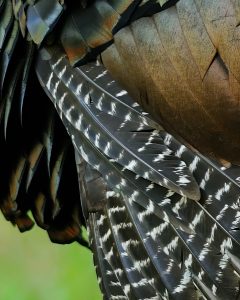
Primary feathers are the stiff, long feathers attached to the rump and wing. These include the typical 18 tail retrices, or fan feathers, which provide flight stability, steering and landing control for the heavy-bodied bird. During mating season, the colorfully displayed fan plays an important role in attracting hens and intimidating rivals. Tip colors in tail feathers and the covert feathers that cover their base vary with subspecies. Brown tips are characteristic of Osceolas, and Easterns. Rio Grandes have tan to buff tips and Merriam’s and Gould’s have whitish tips.
The ten black and white barred primary and 18 or 19 secondary flight feathers are called remiges. Extended, the primaries resemble outstretched fingers and have a long, slightly curved shaft with the vane narrower on the leading side than on the back. Shorter, wider secondaries support the primaries in their function. Specialized covert flight feathers overlay and protect the base of the wing feathers helping to shape them and provide warmth.
Dr. Chamberlain: Wing primaries are attached to the manus (the bird’s hand) and can be individually adjusted like fingers, offering agility in flight. The black and white barring is a way to age birds. Juveniles under a year-old lack barring at the ends of the outermost feathers. Toms use their primaries to draw attention while strutting. The feathers dragging the ground is distinctive to courtship displays. The amount of barring differs across the subspecies. Easterns have slightly more white than black barring, whereas Osceolas have little white barring which makes them appear almost black. Rio Grandes have wing barring that’s mostly equal black to white. Merriam’s and Gould’s have more white than black.
Contour, or body feathers give the bird its shape and colors. A tom’s contour feathers are typically dark with black tips while a hen’s are brownish or gray with
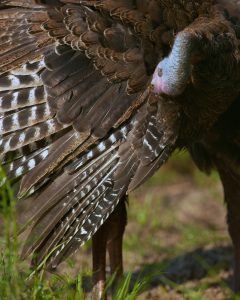
brown to light tips. Contour feathers are layered much like shingles in overlapping rows that form a protective waterproof layer that shields the body. Attached muscles allow the feathers to be held tightly against the body in warm temperatures or fluffed in cold weather to trap air for warmth.
Bristle feathers are hair like feathers that function as sensory tools and grow on the turkey’s head and neck. They’re well developed on hens as shown.
Dr. Chamberlain: We don’t know a ton about bristle feathers although they’ve been studied in other birds. I believe the ones that shield the ear are also bristle feathers, which makes sense because I suspect those feathers assist with sound to the ear and aid the bird in determining directions of sounds. I don’t know that, just a suspicion on my part. The beard is different than the bristle feathers, in that it’s a modified feather that serves primarily in mate attraction (and we believe) status amongst males but similar to other things with turkeys, we really lack an understanding of what all the beard does.
Down feathers, the soft, fluffy white feathers that grow close to the turkey’s body provide excellent insulation by trapping air between the body and the contour feathers. Poults are covered in natal down at hatching, which is rapidly replaced with juvenile feathers.
Turkey Feather Pigmentation and Iridescence Explained
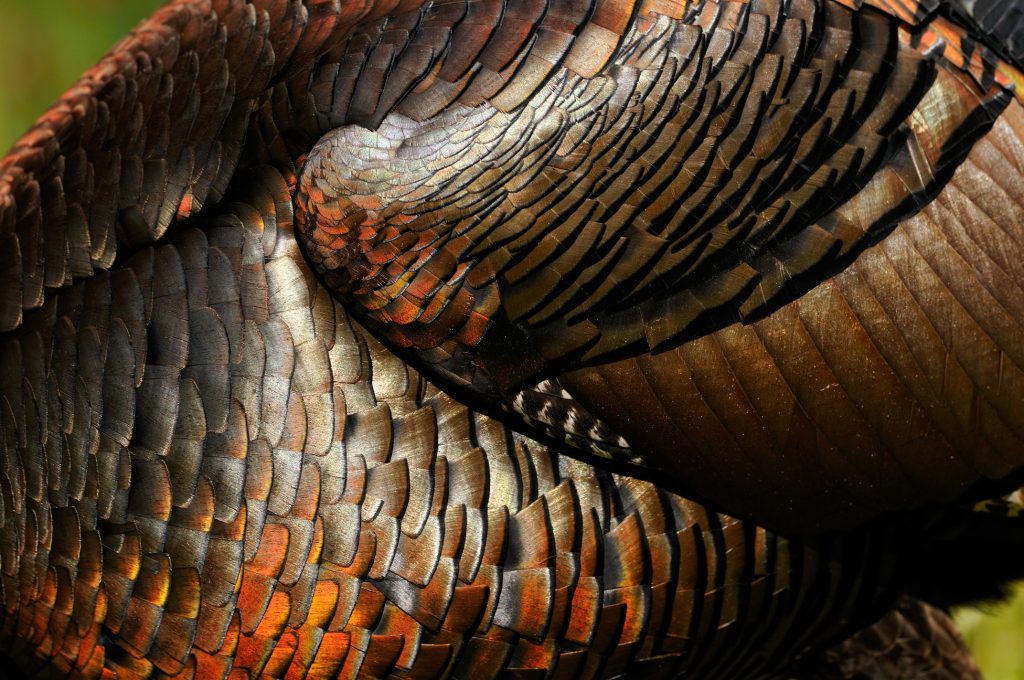
Colors in feathers are formed from pigments or from light refraction caused by the structure of the feather, or a combination of both. Pigments such as melanin are the colored substances found in turkey feathers. Melanin can produce colors from the darkest black to reddish browns and pale yellows. Color abnormalities occur when pigments are present or deficient at unusual levels such as in leucistic or melanistic color phases. Structural colors are produced by the structure of the feather as light is refracted. In wild turkeys, iridescence is caused by light refraction off the structure of the feather barbules.
Dr. Chamberlain: The brilliant colors are caused by light refracting off feathers, rather than feather colors. Crystals within the feathers block certain wavelengths of light but allow others to pass, which controls the intensity of colors. Iridescence which is the phenomenon where a surface appears to change colors as the angle of view changes, creates the brilliant shine that makes toms so stunning. Color and iridescence are an important part of the display toms use, and help hens determine the fittest tom in the breeding population.
Turkey Feathers – a Color Recognition Song for Toddlers and Preschoolers | Music with Miss Jen
FAQ
What color are real turkey feathers?
Coloration varies, but white is typically the dominant tone with black and dark gray contrasting tones, especially on the back, wings and tail feathers.” “The erythristic color phase means the turkey lacks dark pigments,” Hatfield explained. “Birds appear very red, lacking the dark contrasts of traditional plumage.
What are the rare colors of turkeys?
- Albino: A rare condition that results in white skin and feathers, and light pink or red eyes. Only about 1 in 100,000 wild turkeys are albino.
How to tell the difference between a turkey feather and a red tail hawk feather?
Two of the most commonly found large feathers in this area are the Turkey and Red Tail Hawk feathers. Ironically, they are very similar in color and banding. Here are a few ways to tell them apart. The Red Tail Hawk feathers are lighter in color and the bands are much larger.
What do turkey feathers look like?
In general, the feathers of a turkey can be described as brown or white. But the male turkey, like most male birds, usually have “pretty” feathers. Wild turkey feathers shine. They have iridescent feathers that are banded with beautiful colors of red, green, copper and bronze, and gold. Some can even have reddish-brown, gray and black colors.
What is a rare turkey feather color?
While rich brown wild turkey plumage and solid white domestic birds are most common, unusual colors can sometimes occur. Here are some rare turkey feather shades: Albino turkeys lack pigment, resulting in pure white feathers. Lavender or self blue gene produces a light gray color.
What color is a wild turkey?
The most common and recognizable turkey colors are brown and white. The brown feathers help wild turkeys camouflage and blend into the forest floor, while the white feathers create speckled patterns that break up the bird’s outline. This is the natural coloring of wild turkeys in North America.
Why do turkeys have different feather colors?
By selecting birds with different combinations of these genes, breeders can produce turkeys with nearly any feather color they desire. A turkey’s colorful plumage can reveal a lot about its breed, age, gender, and genetic traits. Whether nearly black, white, bronze, or reddish-brown, each feather shade has a meaning.
Do turkeys have white feathers?
Turkeys with white colored feathers are most common and widely raised for meat production. Like domesticated turkeys, wide variety of colorful feathers can also be seen in wild turkeys. The wild male turkeys are banded with iridescent feathers that shine in colors of bronze, copper, gold, green and red.
How to identify wild turkey feathers?
In order to unlock the secrets of wild turkey feather identification, you must first familiarize yourself with the various types of feathers. Turkey feathers come in many shapes and sizes depending on the species – some are short and stiff while others are long and thin.
